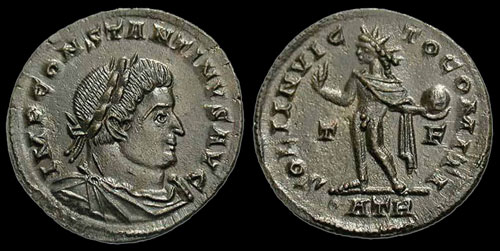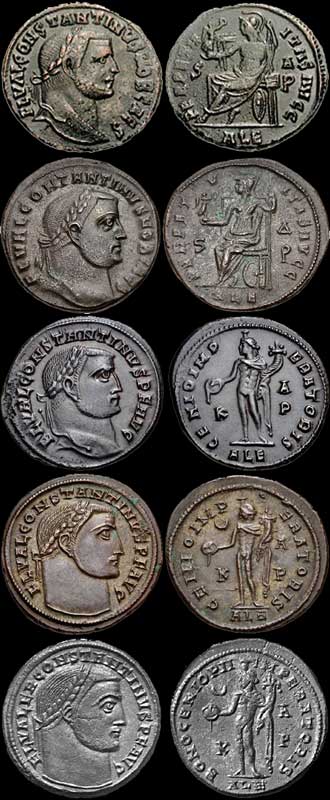
~ Constantine's reign as Roman emperor (A.D. 306-337) dramatically changed the direction of Christianity. Catholic Meaning
Constantinus, surnamed the Great, eldest son of the Emperor Constantius Chlorus and Helena, was born February 27, 272AD Naissus, Moesia [now Niš, Serbia] died May 22, 337AD, Ancyrona, near Nicomedia, Bithynia [now İzmit, Turkey]. His father died at York in 306, and Constantine laid claim to a share of the empire. Galerius acknoledged him with the title of Caesar. He is said to have been converted to Christianity in 312 in the campaign against Maxentius. Just before His death in May 337, Constantine was Baptized by the Arian bishop Eusebius of Nicomedia. In the intervening years he had his wife and eldest son murdered, and from all appearances he continued as a worshipper of the sun god. The "Christianity" Constantine endorsed was already considerably different from that practiced by Yahshua Messiah and the Apostles. At the Council of Nicea 325AD, church authorities essentially replaced the biblical Passover with Easter, a popular holiday rooted in ancient springtime fertility celebrations. Endorsing this change, Constantine announced:
Constantine's affection for sun worship had earlier led him to endorse Sunday, the first day of the week and a day dedicated to honoring the sun, as a weekly day of rest in the Roman empire . This created considerable hardship on those Jews and true Christians who continued to keep the biblical Sabbath on the seventh day of the week. British historian Paul Johnson summarizes how Constantine's approach of merging religious practices produced a corrupted Christianity that meshed paganism with biblical elements:
Constantine's decision to cease the persecution of Christians in the Roman Empire was a turning point for early Christianity, sometimes referred to as the Triumph of the Church, the Peace of the Church or the Constantinian shift. In 313, Constantine and Licinius issued the Edict of Milan decriminalizing Christian worship. The emperor became a great patron of the Church and set a precedent for the position of the Christian emperor within the Church and raised the notions of orthodoxy, Christendom, ecumenical councils, and the state church of the Roman Empire declared by the Edict of Thessalonica in 380. He is revered as a saint and isapostolos in the Eastern Orthodox Church, Oriental Orthodox Church, and various Eastern Catholic Churches for his example as a Christian monarch.
Despite Constantine the Great legalizing Christianity within the Roman Empire, he continued to mint coins bearing pagan imagery and to worship Sol, the Sun God. The cult of Sol had been Rome's official state religion since Aurelian decreed it as such in 274 AD, but Sol had appeared on Roman coins since the time of Septimius Severus, who reigned from 193 to 211 AD. Sol on Roman coins is sometimes referred to as Sol Invictus, which means the Unconquered Sun, with the full name, Deus Sol Invictus, meaning the Unconquered Sun God. On earlier Roman coins, at least from the time of Nero, who reigned from 54 to 68 AD, Sol was referred to as Oriens, though these are different names for the same god. Sol/Oriens originated from the Greek god Helios, frequently depicted on ancient Greek coins, with Helios in turn thought to have had a Mesopotamian origin. Just as with Helios, Sol wears a radiate crown, the spikes representing the rays of the Sun. Just as in the earliest of times, the Sun no doubt was seen as the source of light, warmth, and life, with Sol bringing forth that light, warmth, and life and thereby being worthy of worship. The official worship of Sol ended with the outlawing of paganism by Theodoseus I in 380 AD. Among the most interesting coins featuring Sol are Constantine the Great bronzes having a reverse depicting Sol holding a globus and reaching out with his other hand. The globus, often referred to with the English word "globe," is also often misinterpreted on these coins, regarded as depicting the Earth, as globes typically do today. In actuality this globus is a celestial orb or sphere, which was an ancient depiction of the Cosmos, the Earth being at its center. This is clear from the way it's decorated, which is evident on well-engraved, well-struck, and well-preserved specimens. The markings on it are not of any known land masses at the time but instead represent an equinoctial cross, with the crossing two lines signifying the spring and autumnal equinoxes, the two days of the year in which day and night are equally long. In some cases stars are depicted on the globus as well. The meaning of the design on these coins is Sol, the Sun God, presenting the Cosmos to Constantine, thereby granting him the power to rule everything, a charming example of ancient symbolism.
Consider the vast differences between the mainstream "Christianity" of today and the original Teachings and beliefs of Yahshua Messiah and the Apostles, we can trace much of that change to Constantine and the universal religious system he put in power. Yahshua Messiah did not come to bring a new religion, nor end what was established at Creation and confirmed in writing and in stone when .. As Yahshua Messiah stated: Matthew 5:17-18 Do not think that I came to annul the Torah or the Prophets; I did not come to annul, but to fulfill. |
|
ברוך אתה יי אלוהינו מלך העולם Blessed are You O YAHWEH our ELOHIM, King of the Universe |

|



